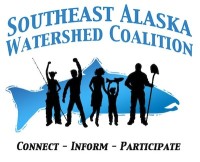
Kake Community Forest Project
The Kake Community Forest project supports the engagement and empowerment, capacity development, and sustainable economic development within the community of Kake. [caption id="" align="aligncenter" width="199"] Kake mill owner Kevin Merry inspects a likely cull Yellow-cedar on a resource inventory field trip.[/caption] In 2011 a collaboration between SEACC, SEAWEAD, and the Organized Village of Kake produced the Kake Community Forest project report. This report included a summary of community and ecological values for the community of Kake as well as descriptions for opportunities to develop a sustainable forest stewardship economy that reflects customary and traditional practices of the local people. Ongoing work stemming from the information included in this report is currently focused on developing capacity for stewardship contracting, development of a small timber and biomass business model and feasibility…
